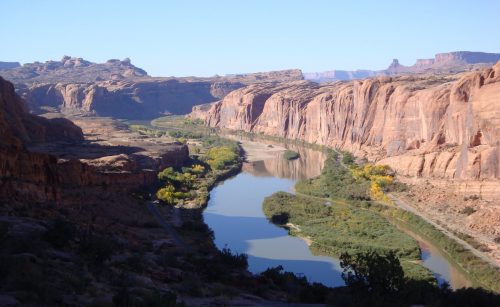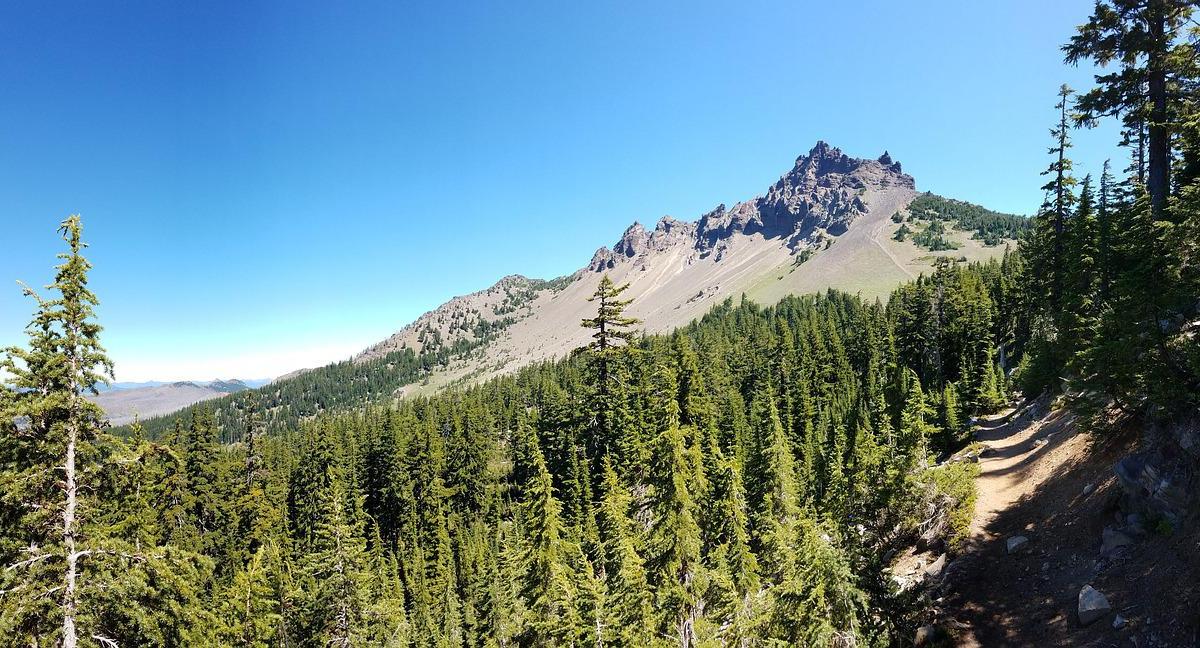In California water news this weekend …
Weather’s unwanted guest: Nasty La Nina keeps popping up
 “Something weird is up with La Nina, the natural but potent weather event linked to more drought and wildfires in the western United States and more Atlantic hurricanes. It’s becoming the nation’s unwanted weather guest and meteorologists said the West’s megadrought won’t go away until La Nina does. The current double-dip La Nina set a record for strength last month and is forecast to likely be around for a rare but not quite unprecedented third straight winter. And it’s not just this one. Scientists are noticing that in the past 25 years the world seems to be getting more La Ninas than it used to and that is just the opposite of what their best computer model simulations say should be happening with human-caused climate change. … ” Read more from CBS News here: Weather’s unwanted guest: Nasty La Nina keeps popping up
“Something weird is up with La Nina, the natural but potent weather event linked to more drought and wildfires in the western United States and more Atlantic hurricanes. It’s becoming the nation’s unwanted weather guest and meteorologists said the West’s megadrought won’t go away until La Nina does. The current double-dip La Nina set a record for strength last month and is forecast to likely be around for a rare but not quite unprecedented third straight winter. And it’s not just this one. Scientists are noticing that in the past 25 years the world seems to be getting more La Ninas than it used to and that is just the opposite of what their best computer model simulations say should be happening with human-caused climate change. … ” Read more from CBS News here: Weather’s unwanted guest: Nasty La Nina keeps popping up
Gray declares victory in effort to keep reservoir projects moving forward
“Assemblyman Adam Gray (D-Merced) put together a bipartisan coalition to defeat a bill that would have prohibited the State Water Board from issuing new water right permits. The bill’s defeat came in a showdown Thursday between Gray and the author of the legislation, Assemblyman Bill Quirk of Hayward, a fellow Democrat. According to Gray, Assembly Bill 2639 would have jeopardized new water storage projects such as Sites Reservoir in the drought-ravaged state. Sites is one of seven water storage projects eligible for funding from a 2014 voter-approved state water bond. In March, the federal government signaled its intent to loan the Sites project nearly $2.2 billion — about half of the cost to design, plan and build it. … Read more from GV Wire here: Gray declares victory in effort to keep reservoir projects moving forward
Solano County supervisors reiterate opposition to Delta tunnel project

“Solano County supervisors this week made it clear they do not support any Delta tunnel project whether it is two tunnels as was proposed by the Jerry Brown administration or a single tunnel as proposed by Gov. Gavin Newsom. The board on Tuesday adopted a resolution reaffirming Solano’s support for the Delta Counties Coalition. Supervisor Mitch Mashburn, who represents Solano on the coalition, equated the 40-plus mile Delta conveyance tunnel to a straw that is being built to suck 6,000 cubic feet of water, per second, from two intake points above the Sacramento-San Joaquin Delta to a release point below the estuary. “We don’t need a straw; we need a bigger cup,” said Mashburn … ” Read more from the Daily Republic here: Supervisors reiterate opposition to Delta tunnel project
SEE ALSO: The Delta Conveyance Project: A proposal to protect water supplies for the future
The failed recovery plan for the Delta and Delta Smelt
Peter Moyle writes, “Few native species are as controversial as Delta Smelt. It is a 3-4 inch translucent fish that lives only in the California Delta, where the Sacramento and San Joaquin rivers meet. This place also happens to be the heart of California’s complex water supply system which provides fresh drinking water to 35-million Californian’s and supports a multi-billion dollar agricultural industry. As water demand increased over the years, the smelt declined, approaching extinction. This blog probes into lessons we can learn from the failure of efforts to protect the smelt, laid out in the 1990s. … ” Read more from the California Water Blog here: The Failed Recovery Plan for the Delta and Delta Smelt
After nixing 50-million-gallon-a-day desalination plant, California demands residents use less water
“California residents were slapped with tighter water restrictions Tuesday two weeks after state officials spiked plans for a $1.4 billion saltwater desalination plant in Orange County amid a season of historic drought. The State Water Resources Control Board unanimously voted to implement a statewide watering ban for ornamental lawns at businesses and commercial properties as residents brace for a prolonged drought, the driest drought of its length in 1,200 years. Local government will also be required to reduce water use by up to 20 percent. … ” Read more from the Federalist here: After nixing 50-million-gallon-a-day desalination plant, California demands residents use less water
Millions in state grants awarded to support regional responses to challenging water supplies
“The California Department of Conservation today announced the award of more than $40 million to regional organizations working to reduce groundwater reliance and create local environmental and economic opportunities through land-use changes. These organizations, which operate in five important agricultural counties, are the first recipients of funding from the Multibenefit Land Repurposing Program, part of Governor Newsom’s multi-faceted response to the ongoing drought. “Worsening drought and depleted groundwater are unfortunate realities in California,” said David Shabazian, director of the state’s Department of Conservation, which oversees the land program. “We are supporting local governments, farmers, ranchers, and other stakeholders in exploring whether some agricultural lands might be put into alternative uses to reduce water demand and the burden on local aquifers.” … ” Read more from the Department of Conservation here: Millions in state grants awarded to support regional responses to challenging water supplies
California faces power shortages and price hikes amid drought woes: report

Photo courtesy of the Department of Water Resources
“California faces the grim prospect of a drought-fueled summer of power shortages, hydroelectric plant shutdowns and rising electricity costs in areas where PG&E and other utilities provide services, a report released Friday warns. The drought could deplete big reservoirs in California such as Shasta Lake and Lake Oroville to the extent that the hydroelectric plants at those sites might have to suspend operations, according to the report from the U.S. Energy Information Administration. The forbidding electricity scenarios have surfaced due to an alarming drop in water levels at reservoirs throughout California. As of April 1, Shasta was at just 48% of historical average storage while Oroville was at 67%, the report said. ... ” Read more from the San Jose Mercury News here: California faces power shortages and price hikes amid drought woes: report
Disaster upon disaster: Wildfires are contaminating the West’s depleting water with ashy sludge
“Officials in Las Vegas, New Mexico, had barely finished battling the massive Calf Canyon-Hermits Peak wildfire earlier this month before they had to point their defenses toward another threat: the ash-filled erosion that could pollute their water. … Megafires aren’t just burning down homes, trees and wildlife in the West. They’re also destabilizing the soil. When it rains, thousands of tons of charred sediment flow into rivers and reservoirs used for drinking water. The Gallinas River, for example, supplies about 90 percent of the water for Las Vegas. “It’s literally like tasting dirt,” said Andy Fecko, general manager at the Placer County Water Agency in Auburn, California, a city that sits between Sacramento and Lake Tahoe. … ” Read more from CNN here: Disaster upon disaster: Wildfires are contaminating the West’s depleting water with ashy sludge
How one of California’s most famous trails may become ‘all but impossible’ to hike
 “The Pacific Crest Trail is supposed to provide an escape from society, a place where a person can unplug and explore the wild and scenic landscapes that inspired America’s early naturalists. But increasingly it is morphing into an exhibition of ecological deterioration wrought by the warming climate. Higher temperatures, less snow and ice, dry springs, wildfires, smoky skies and denuded forests have come to define the experience of hiking the 2,600-mile trail, which extends from Mexico to Canada through the mountains of California, Oregon and Washington. The current generation of hikers is already having to adapt. “I’ve started carrying N95 masks with me while hiking,” said Brad Marston, a climate physics professor at Brown University who has hiked sections of the trail for the past nine years. While traversing a High Sierra segment in 2013, he said, “I had to get off the trail for a while because the smoke was too bad.” … ” Continue reading at the San Francisco Chronicle here: How one of California’s most famous trails may become ‘all but impossible’ to hike
“The Pacific Crest Trail is supposed to provide an escape from society, a place where a person can unplug and explore the wild and scenic landscapes that inspired America’s early naturalists. But increasingly it is morphing into an exhibition of ecological deterioration wrought by the warming climate. Higher temperatures, less snow and ice, dry springs, wildfires, smoky skies and denuded forests have come to define the experience of hiking the 2,600-mile trail, which extends from Mexico to Canada through the mountains of California, Oregon and Washington. The current generation of hikers is already having to adapt. “I’ve started carrying N95 masks with me while hiking,” said Brad Marston, a climate physics professor at Brown University who has hiked sections of the trail for the past nine years. While traversing a High Sierra segment in 2013, he said, “I had to get off the trail for a while because the smoke was too bad.” … ” Continue reading at the San Francisco Chronicle here: How one of California’s most famous trails may become ‘all but impossible’ to hike
Wildlife Conservation Board funds Environmental Improvement and Acquisition Projects
“At its May 26, 2022 quarterly meeting, the Wildlife Conservation Board (WCB) approved approximately $52.93 million in grants to help restore and protect fish and wildlife habitat throughout California. Some of the 33 approved projects will benefit fish and wildlife — including some endangered species — while others will provide public access to important natural resources. Several projects will also demonstrate the importance of protecting working landscapes that integrate economic, social and environmental stewardship practices beneficial to the environment, landowners and the local community. … ” Read more from the Department of Fish and Wildlife here: Wildlife Conservation Board funds Environmental Improvement and Acquisition Projects
In commentary this weekend …
Dan Walters: As drought persists, water rights on agenda
Dan Walters writes, “As a third year of drought continues, California officialdom is increasing pressure for more water conservation. Last week, the state Water Resources Control Board imposed a statewide ban on watering of “non-functional” turf, such as grass around commercial buildings, and directed local water agencies to implement water use restrictions. “California is facing a drought crisis and every local water agency and Californian needs to step up on conservation efforts,” Gov. Gavin Newsom said in a supportive statement. Despite the official ballyhoo, last week’s actions were tepid at best, stopping well short of the mandatory reductions that Newsom’s predecessor, Jerry Brown, imposed during a previous drought. … ” Read more from Cal Matters here: Dan Walters: As drought persists, water rights on agenda
Impaired fish flows & Delta tunnel: The state plan to make drought devastating for northern SJ Valley
Dennis Wyatt, editor of the Manteca Bulletin, writes, ““We” — referring to those of us that live, work and play in the Northern San Joaquin Valley — supposedly don’t get it when it comes to the importance of the environment. This nugget of wisdom was offered by pundits in reaction to how many of us in the 209 believe the myopic plan to ratchet up unimpaired flows from February to June on the Stanislaus, Merced and Tuolumne rivers will do fish little if any good while causing severe damage to farming, urban water users in the three counties, body slam the regional economy, and even hurt the environment miles away from the three previously mentioned rivers. I’m not too sure what “we” don’t get. … ” Continue reading at the Manteca Bulletin here: Impaired fish flows & Delta tunnel: The state plan to make drought devastating for northern SJ Valley
Newsom should act to preserve our water
The Santa Barbara News-Press editorial board writes, “Did you know that the California Coastal Commission, of which Santa Barbara City Councilmember Meaghan Harmon is a member, rejected a water desal permit application for a plant in Orange County, like the one now operational in Carlsbad? This Orange County project planned for the last 20 years, was designed to supply water to 16% of a population of 3.1 million people. That equals 50 million gallons of drinking water per day. But not now. Is it only in California that it takes 20 years to apply for a permit only to have it rejected? … ” Continue reading at the Santa Barbara News-Press here: Newsom should act to preserve our water
Coastal Commission’s water obstructionism
Jim Shields writes, “Last week, the California Coastal Commission rejected the proposed construction of a desalination plant in Huntington Beach “sealing the controversial project’s fate after more than 20 years of debate,” according to Calmatters. “The unanimous decision about the $1.4-billion plant in Huntington Beach is pivotal because it sets a high bar for the future of turning seawater into drinking water in California, which can help buffer its vulnerable water supply against drought. The Coastal Commission staff had advised the commission to deny approval — citing, among other factors, the high cost of the water and lack of local demand for it, the risks to marine life and the possibility of flooding in the area as sea levels rise.” What a crock. Guess the Commission is unaware that California is in a historic extended drought that calls for trying to solve water shortage problems, not exacerbating them. For example, desal plants would certainly offset, to some degree, rise in sea levels as coastal waters are processed into potable water. … ” Continue reading at the Anderson Valley Advertiser here: Coastal Commission’s water obstructionism
The Abundance Choice, Part 8: The Union Factor: The power of environmentalists in California is literally strangling the state’s economy
Edward Ring, a contributing editor and senior fellow with the California Policy Center, writes, “The moment we met Robbie Hunter, then president of the State Building and Construction Trades Council, we knew we were in the presence of a man who does not lose. Assemblyman Devon Mathis had urged me to contact the construction unions before we finished our research to write the initiative and began an actual campaign, and through one of his mutual contacts, the meeting was arranged. Three of us arrived at the SBCTC’s offices in downtown Sacramento back in August 2021, all of us dressed in our Sunday best; suits, ties, dress shoes. Hunter met us in their lobby, dressed like a man who does real work, wearing a t-shirt with a union logo on the front. As someone without experience meeting a union president, much less negotiating with one, Hunter, a burly man with a trace of an Irish accent, fit the stereotype I’d imagined. And that first meeting was encouraging. … ” Continue reading at the California Globe here: The Abundance Choice, Part 8: The Union Factor: The power of environmentalists in California is literally strangling the state’s economy
In people news this weekend …
 Marin Municipal Water District director Cynthia Koehler to exit
Marin Municipal Water District director Cynthia Koehler to exit
“After nearly two decades as a Marin Municipal Water District director, Cynthia Koehler has announced she will not seek reelection in November. Koehler, a longtime environmental attorney, has been on the district’s board since 2005 and represents Mill Valley, Sausalito and other areas west of Highway 101 in southern Marin. Koehler said she decided not to seek reelection because of upcoming opportunities and projects in her nonprofit organization, the WaterNow Alliance. She is a co-founder and the executive director. … ” Read more from the Marin Independent Journal here: Marin Municipal Water District director Cynthia Koehler to exit
Podcasts …
WATER IS A MANY SLPENDOR’ED THING PODCAST: A Water Purveyor’s Worst Nightmare
 Steven Baker writes, “How far have we come since the Central Valley water squeeze of 2009-2010? I met with Westland Water District during the severe water allocation reductions of 2009. It was Sarah Wolfe who shared the realities of how water shortage impacts the bread basket of America. Compare for yourself Sarah’s description of the District with today’s experience and ask yourself; How can the Central Valley become more successful as the uncertainty of yearly water deliveries broaden? Water is a Many Splendor’ed Thing brings you another water relationship that has a personally significant impact to your life.” Podcast produced by Steven Baker, Bringing People Together to Solve Water Problems, water@operationunite.co
Steven Baker writes, “How far have we come since the Central Valley water squeeze of 2009-2010? I met with Westland Water District during the severe water allocation reductions of 2009. It was Sarah Wolfe who shared the realities of how water shortage impacts the bread basket of America. Compare for yourself Sarah’s description of the District with today’s experience and ask yourself; How can the Central Valley become more successful as the uncertainty of yearly water deliveries broaden? Water is a Many Splendor’ed Thing brings you another water relationship that has a personally significant impact to your life.” Podcast produced by Steven Baker, Bringing People Together to Solve Water Problems, water@operationunite.co
In regional water news this weekend …
NORTH COAST
Big Springs Irrigation District lawsuit extended again, now on its third judge
“The Big Springs Irrigation District (BSID) learned Thursday that its civil lawsuit versus the California State Water Resources Control Board (state water board) has been pushed back for another hearing on June 16th. Thursday morning, May 26, attorneys from both parties met privately via zoom with the newest judge assigned to oversee the case. The new hearing will now take place on June 16th, via zoom and also with limited space available for the public at the Siskiyou County Courthouse. ... ” Read more from KRCR here: Big Springs Irrigation District lawsuit extended again, now on its third judge
Amid drought, Humboldt County cities consider how to implement water restrictions
“California’s State Water Board voted to implement new statewide regulations restricting water use in the face of drought on Tuesday. The board banned watering non-functional turf in commercial, industrial and institutional sectors, and requires local agencies to enact water use restrictions, which could include limiting outdoor irrigation and identifying water waste. While the new regulations were adopted in the face of drought, which Humboldt County is in, county water supplies are not close to danger, according to John Friedenbach, general manager of the Humboldt Bay Municipal Water District which provides water to around 80,000 customers. … ” Read more from the Eureka Times-Standard here: Amid drought, Humboldt County cities consider how to implement water restrictions
MOUNTAIN COUNTIES
Waterproof water trail map helps paddlers access all 72 miles of Lake Tahoe
“Get ready to paddle 72-miles of pure liquid fun with the official Lake Tahoe Water Trail Map & Access Guide from Sierra Business Council. This essential paddle guide pinpoints 37 public launch and landing sites, 20 Trailheads with signage, restrooms, and parking, Day Trip Maps, camping, mapped paddle routes, water safety, and all the tools you need for planning a safe and fun adventure. ... ” Read more from South Tahoe Now here: Waterproof water trail map helps paddlers access all 72 miles of Lake Tahoe
Van Norden Meadow on track for restoration in summer of 2022
“The South Yuba River Citizens League (SYRCL) was awarded $3.746 million from the Wildlife Conservation Board’s Forest Conservation grant program to implement Phase One of restoration of Van Norden Meadow (Yayalu Itdeh in Washoe) in partnership with Tahoe National Forest (TNF). The 485-acre meadow is located at the headwaters of the South Yuba River. SYRCL and TNF are focusing on restoring Van Norden because it is one of the largest meadows on the west side of the Northern Sierra and is critical for water storage, water quality, wildlife habitat, and forest resiliency. Healthy functioning meadows can also store as much carbon acre-for-acre as a rainforest. … ” Read more from YubaNet here: Van Norden Meadow on track for restoration in summer of 2022
Tuolumne County authorities continue warning of dangerous, cold water conditions
“The Tuolumne County Sheriff’s Office and the Forest Service are continuing to warn of dangerous conditions in cold waters of local reservoirs and lakes and the cold, fast-moving waterways of the Mother Lode and the Stanislaus National Forest. The three-day Memorial Day Weekend is this Saturday, Sunday and Monday. Public safety agencies are warning people about dangerous springtime-summertime dangers in snowmelt-fed waterways because fatal incidents happen, like less than two weeks ago at God’s Bath on the Clavey River. … ” Read more from the Union-Democrat here: Tuolumne County authorities continue warning of dangerous, cold water conditions
SACRAMENTO VALLEY
When steamboats plied the Sacramento River
“Sternwheelers Steamed Along The Sacramento, by Margaret Bauer, published in 1983 Tehama County Memories. Steam boats were churning up the Sacramento as far as Squaw Hill, Tehama and Red Bluff from the earliest days of American settlement, and were an exhilarating sight in Tehama County until well into this century. Almost before the ink was dry on his Mexican land grant back in 1844, Peter Lassen was intrigued with the possibilities of steam boats serving this area. In the gold rush year of 1849, he bought the little Washington, loaded her with goods, and laboriously worked her upriver to his rancho at the mouth of Deer Creek. … ” Read more from the Red Bluff Daily News here: When steamboats plied the Sacramento River
CDFW Report: 19,773 out of 21,580 spring Chinook salmon died before spawning on Butte Creek in 2021
Dan Bacher writes, “The California Department of Fish and Wildlife has just published their monitoring report on 2021’s spring Chinook salmon run on Butte Creek, a tributary of the Sacramento River in Northern California. The number of adult spring-run Chinooks that perished before spawning is worse than the preliminary estimate by the CDFW in October 2021, when the CDFW estimated that 14,500 out of 18,000 to 20,000 fish had perished before spawning. In summary, the pre-spawning mortality of these endangered fish was estimated at only 19,773 out of 21,580 fish total. Only an estimated 1,807 adults survived to spawn. … ” Read more from the Daily Kos here: CDFW Report: 19,773 out of 21,580 spring Chinook salmon died before spawning on Butte Creek in 2021
‘We’re in uncharted territory’: drought drops rice production to historic low

“Coming into the third year of severe drought, state and federal surface water restrictions are forcing rice farmers in Butte County and other north state counties to plant less acres of rice than normal which could have lasting effect on job opportunities. With less water allocated to farmers along the Sacramento and Feather rivers, many fields will be left bare, according to Luis Espino, rice farming systems adviser and director at the University of California Butte County Cooperative Extension. Espino said he expects the acres of rice planted in Butte County should be about 60% to 80% of normal. But in Glenn and Colusa counties, Espino estimates only about 10% of normal will be planted. “We expect lower acreage in 2022. We already had lower acreage in 2021,” Espino said. … ” Read more from the Sacramento Bee here: ‘We’re in uncharted territory’: drought drops rice production to historic low
‘Return to the river’: Feather River Parkway plans introduced to help bring people back
“On a cool and beautiful Friday morning, several county officials gathered for a press conference along the edge of the Feather River in Yuba City to call attention to a plan to revitalize the area and bring much-needed recreational opportunities. Included in that plan is a new riverfront parkway consisting of woodlands, wetlands and trails along the Feather River in Sutter County, Chuck Smith, public information officer for the county said. Officials with the county also are “encouraging the community” to be a part of a citizen’s committee to help shape what the new parkway will become. … ” Read more from Yahoo News here: ‘Return to the river’: Feather River Parkway plans introduced to help bring people back
Southern California gets drastic water cutbacks amid drought. What’s next for Sacramento?
“Faced with severe statewide drought, a large Southern California water district this week announced dramatic restrictions curtailing water use for some 6 million residents. Gov. Gavin Newsom in late March issued an executive order calling for local water agencies to reduce water usage and tighten conservation, but he did not order any mandatory statewide cutbacks. Less than a month later, the Metropolitan Water District of Southern California on Tuesday declared a water shortage emergency and announced new restrictions, which will kick in June 1. … ” Read more from the Sacramento Bee here: Southern California gets drastic water cutbacks amid drought. What’s next for Sacramento?
NAPA/SONOMA
Sonoma Water petitions state for critical water condition for Russian River as severe drought enters third consecutive year
“On Wednesday, May 25 Sonoma Water (Sonoma County Water Agency) filed Temporary Urgency Change Petitions (TUCP) with the State Water Resources Control Board to establish a Critical water supply condition for both the upper and lower Russian River as the drought continues. Under Critical water supply conditions, the Russian River would have minimum instream flow requirements of 25 cfs and 35 cfs in the upper and lower river, respectively. If approved, this change will allow Sonoma Water to continue the minimum instream flows that the river is currently operating under and preserve water supply in both Lake Mendocino and Lake Sonoma. … ” Read more from Sonoma County here: Sonoma Water petitions state for critical water condition for Russian River as severe drought enters third consecutive year
Lessons in water saving from a local public garden
“The average yearly rainfall in Santa Rosa is about 38 inches. Yet, 10 months into the annual rainfall year, calculated from July 1 to July 1, the city has received only slightly more than 26 inches. It’s another dry year in a succession of critically dry years. Similar dismal rainfall counts have been recorded all over the North Coast and the state. Statewide, the Sierra snowpack now sits at 38% of average, about a third of where it is normally at this time of year. That means that this summer, those of us with food and ornamental gardens have to conserve as much water as we can, and many already have taken measures to reduce water consumption. So what are the best strategies for saving water? Where can we turn for solid, practical information? … ” Read more from the Santa Rosa Press Democrat here: Lessons in water saving from a local public garden
BAY AREA
Marin water agency gets drought stress-test tool
“The Marin Municipal Water District has unveiled a new tool that will model how reliable its reservoir supply would be in more extreme droughts and how new water sources could help. This week, Jacobs Engineering, a consulting firm to the district, provided a first look at a model that shows how the utility’s two-year reservoir supply would fare under worsening drought conditions and from catastrophes such as fires or landslide damage. “We’ve not yet experienced a four-year drought, and I think with a system like yours, that unless there is a substantial wet season in between you tend to deplete storage quite a bit faster,” Armin Munevar, the consulting project manager, told the district board on Tuesday. … ” Read more from the Marin Independent Journal here: Marin water agency gets drought stress-test tool
Algae closes Del Valle Park to swimmers
“Although warm weather is here and the traditional swim season starts this Memorial Day weekend, swimming and wading are currently banned at Del Valle Regional Park south of Livermore because of the hazards brought on by blue green algae blooms. The ban includes pets as well as people. Signs prohibiting swimming and wading are posted at the park as well as on the website of the East Bay Regional Park District, which manages Del Valle for the California Department of Water Resources. … ” Read more from the Independent here: Algae closes Del Valle Park to swimmers
CENTRAL COAST
Scotts Valley’s famously awful drinking water gets upgrade
“Famously foul drinking water in Scotts Valley looks to be a thing of the past, after a ratepayer-funded $3.5 million upgrade to the main treatment plant. Scotts Valley Water District officials this week held a blind tasting — comparing the “new” water from the Orchard Run plant to that of an unnamed local water provider and an unnamed bottled water company. Scotts Valley Fire Chief Ron Whittle said he successfully identified the Scotts Valley water in the taste test. “This was actually really good,” Whittle said. ... ” Read more from the Santa Cruz Sentinel here: Scotts Valley’s famously awful drinking water gets upgrade
Santa Cruz grand jury pushes for greater water supply resiliency, collaboration
“As impacts of the lengthening drought unfurl statewide, a Santa Cruz County government watchdog panel is asking why local efforts to create sustainable water supplies do not go even further. “The County has the means to achieve drought resilience,” the Santa Cruz Civil Grand Jury 2021-2022 panel wrote in the summary of its latest report. “What’s been missing is urgency and tightly integrated, cross-agency collaboration to accelerate this work. Although considerable interagency collaboration has been demonstrated, it has not resulted in the leadership needed to turn plans into action. The time to act is now.” … ” Continue reading at the Santa Cruz Sentinel here: Santa Cruz grand jury pushes for greater water supply resiliency, collaboration
Monterey Peninsula water users to be subject to restrictions, fines
 “Come Wednesday, Monterey Peninsula water users will face new conservation restrictions that when voluntary compliance doesn’t work, fines could follow. On Thursday, the board of directors of the Monterey Peninsula Water Management District, following a state order handed down Tuesday, adopted a resolution that lays out the specifics of what is deemed Stage 2 water conservation requirements. Gov. Gavin Newsom on March 28 issued an executive order requiring the California State Water Resources Control Board to come up with orders by May 25. The water board came in with its Stage 2 ruling a day before schedule. … ” Read more from the Monterey Herald here: Monterey Peninsula water users to be subject to restrictions, fines
“Come Wednesday, Monterey Peninsula water users will face new conservation restrictions that when voluntary compliance doesn’t work, fines could follow. On Thursday, the board of directors of the Monterey Peninsula Water Management District, following a state order handed down Tuesday, adopted a resolution that lays out the specifics of what is deemed Stage 2 water conservation requirements. Gov. Gavin Newsom on March 28 issued an executive order requiring the California State Water Resources Control Board to come up with orders by May 25. The water board came in with its Stage 2 ruling a day before schedule. … ” Read more from the Monterey Herald here: Monterey Peninsula water users to be subject to restrictions, fines
Ornamental lawns targeted in Peninsula’s newly tightened water restrictions
“Starting June 1, ornamental lawns, including common areas in homeowner associations, cannot be irrigated with drinking water; restaurants cannot serve customers water unless requested and hosing down a walkway or driveway is prohibited under new water restrictions approved by local Monterey Peninsula water regulators May 26. The Monterey Peninsula Water Management District unanimously approved moving into Stage 2 water restrictions as the county and state move further into an extended drought. The U.S. Drought Monitor shows much of Monterey County suffering “severe drought,” with the southeastern corner of the county experiencing the more intense “extreme drought.” … ” Read more from Monterey County Weekly here: Ornamental lawns targeted in Peninsula’s newly tightened water restrictions
New water restrictions are coming to these SLO County cities. Here’s what it means to you
“Some San Luis Obispo County cities must implement tighter water use restrictions after the California Water Quality Control Board voted Tuesday to adopt an emergency regulation in response to the ongoing drought. The emergency regulation adopted by the state board also prohibits using drinkable water to irrigate “non-functional turf,” or decorative grass, at commercial, industrial and institutional properties. By June 10, urban water suppliers must implement Level 2 of their water shortage contingency plans to achieve a 10% to 20% reduction in water consumption, the new regulation says. The regulation was adopted mostly in line with an executive order by Gov. Gavin Newsom on March 28. … ” Read more from the San Luis Obispo Tribune here: New water restrictions are coming to these SLO County cities. Here’s what it means to you
SOUTHERN CALIFORNIA
Talking on water: MWD chief on the present and future drought
 “We face a long, hot and dry fire season ahead. Southern California’s worst three years of rainfall on record has triggered unprecedented limits on water usage. But now for the bad news: get used to it. Climate change means a new normal. Southern California’s once-reliable sources of water no longer provide a stable, adequate supply for our 20 million people. That’s the realistic perspective that the head of the Metropolitan Water District is relentlessly hammering home. Met General Manager Adel Hagekhalil is responsible for supplying 1.5 billion gallons of water annually to the utilities that in turn serve our homes and businesses. He knows “we have short memories.” But he’s determined to look past the current drought crisis — and not allow a future wet year to divert us from facing the brutal long-term reality. “Everything is upended,” Hagekhalil declares. “Business as usual is over. … ” Read more from the San Bernardino Sun here: Talking on water: MWD chief on the present and future drought
“We face a long, hot and dry fire season ahead. Southern California’s worst three years of rainfall on record has triggered unprecedented limits on water usage. But now for the bad news: get used to it. Climate change means a new normal. Southern California’s once-reliable sources of water no longer provide a stable, adequate supply for our 20 million people. That’s the realistic perspective that the head of the Metropolitan Water District is relentlessly hammering home. Met General Manager Adel Hagekhalil is responsible for supplying 1.5 billion gallons of water annually to the utilities that in turn serve our homes and businesses. He knows “we have short memories.” But he’s determined to look past the current drought crisis — and not allow a future wet year to divert us from facing the brutal long-term reality. “Everything is upended,” Hagekhalil declares. “Business as usual is over. … ” Read more from the San Bernardino Sun here: Talking on water: MWD chief on the present and future drought
Column: How many $313,000 water executives does O.C. really need?
“Fun fact No. 1: Orange County is one of California’s smallest when measured by square miles (a compact 791). Fun fact No. 2: Despite the density of our little slice of paradise, it takes18 completely separate, independent little governments to make water gush from our taps and flush wastewater away — in addition to the baker’s dozen of cities that have their own water departments. Fun fact No. 3: These completely independent little governments, tied to no city or county and operating largely beyond the public gaze, employ thousands of people — 2,155, to be exact, including more than 120 directors and board members, 61 plant operators and senior plant operators, 45 senior engineers, 38 senior mechanics, 18 well-paid general managers and their assistants and so on. … ” Continue reading at the OC Register here: Column: How many $313,000 water executives does O.C. really need?
Which Southern California cities face water cutbacks on June 1? What we know
“About 6 million residents of Southern California will soon be reduced to one-day-a-week watering under sweeping new restrictions driven by severe drought and climate change. The first-of-its-kind mandatory action from the Metropolitan Water District of Southern California will take effect June 1 and cover communities from Los Angeles, Ventura and San Bernardino counties — but not all of them. The rules will target areas that rely heavily or entirely on the State Water Project, a Northern California water supply that officials say runs the real risk of running dry. Areas that receive water from the Colorado River and other sources will be spared, at least for now. … ” Read more from the LA Times here: Which Southern California cities face water cutbacks on June 1? What we know
Take shorter showers during a drought? Why don’t you stop watering your lawn first?
” … Driven by worsening drought conditions and reduced supplies from the complex system of reservoirs, canals and dams that supplies water to millions, the Metropolitan Water District issued its strictest-ever water cuts last month. Starting June 1, nearly 4 million customers in Los Angeles will face new restrictions on water use, with outdoor watering limited to two days per week. Gov. Gavin Newsom told the state’s largest water suppliers last week that if conservation efforts don’t improve this summer, the state could be forced to impose mandatory restrictions. Water use in cities and towns across California rose by nearly 19% in March compared with 2020, according to state officials. Showers aren’t in the crosshairs yet. But officials are encouraging Californians to save water wherever they can, including in the shower, one of the easiest places to waste — or conserve — a few gallons a day. … ” Read more from the LA Times here: Take shorter showers during a drought? Why don’t you stop watering your lawn first?
Chino Hills enacts Stage III water alert
“The Chino Hills City Council on Tuesday night declared a Stage III High Conservation Alert, effective June 1, in response to drought conditions and the governor’s executive order that called for an overall 20 to 30 percent reduction statewide. The City of Chino does not have anything similar that will be immediately implemented, said city spokesperson Vivian Castro. “We are in the process of drafting something for the near future,” she said. ... ” Read more from the Chino Hills Champion here: Chino Hills enacts Stage III water alert
IMPERIAL/COACHELLA VALLEYS
Commentary: A new ‘gold rush’ for lithium at Salton Sea could hurt Native lands, as mining often does
Preston J. Arrow-weed, a Quechan and Kumeyaay educator, environmentalist, actor, playwright, and singer, writes, “They say the only people who made money during the gold rush were the people selling picks and shovels. Folks were so focused on getting rich they stopped thinking straight. They made bad decisions. Went broke. According to the Quechan creation story, gold comes from the blood of a giant snake. It is said that digging up this gold can only bring death, so we try not to mess with it. Yet companies like KORE mining keep trying to destroy our sacred sites at Indian Pass, in eastern Imperial County, to dig for gold. They only think about the millions and millions of dollars they can make, not about the destruction they will bring to desert ecosystems and our Native community. ... ” Read more from the Desert Sun here: Commentary: A new ‘gold rush’ for lithium at Salton Sea could hurt Native lands, as mining often does
SAN DIEGO
How San Diego secured its water supply, at a cost
“As a worsening drought forces millions of Californians to face mandatory water restrictions, one corner of Southern California has largely shielded itself from supply-related woes: San Diego County. For Western water planners, the path it took to get there serves either as a blueprint or a cautionary tale. Over the past three decades, San Diego County diversified its water supply, ramped up conservation and invested in big-ticket water infrastructure including the Western hemisphere’s largest desalination plant, which removes salt and impurities from ocean water. As a result, the water agency that serves 24 water utilities including the city of San Diego says it can avoid cuts until at least 2045, even during dry periods. But that security has come at a cost. … ” Read more from the AP here: How San Diego secured its water supply, at a cost
Along the Colorado River …
Morning Scoop panel discusses water shortage issues and solutions facing the Southwest

“Water, as described at the start of a panel discussion Tuesday on Arizona’s water supplies, is “one of the hottest topics around.” It certainly is. And for a lot of uncomfortable reasons, as people in the drought-plagued Southwest are learning. The latest “Morning Scoop” panel discussion sponsored by the Arizona Capitol Times focused on a broad overview of the water issues facing Arizona. Some of them, like surface water supplies maintained by the Salt River Project, appear to be in good shape following reasonably good spring runoff into SRP’s system of reservoirs. ... ” Read more from the Arizona Department of Water Resources here: Morning Scoop panel discusses water shortage issues and solutions facing the Southwest
Former Southern Nevada Water Authority chief ‘very worried’ about Lake Mead level
“Lake Mead, the lifeblood of the West, is at an all-time low. And just this week, officials said it will fall by one-third of its current level by the end of 2023. Inch by inch, the lake is falling. We’re seeing incredible images of sunken boats now visible. We saw the first intake pipe, built in the early 1970s to feed Las Vegas, exposed to the air, no longer able to bring water to the city. And the body in the barrel, possibly a remnant of Las Vegas’ Mob past. … For Pat Mulroy, that means she’s “very worried.” ... ” Read more from KNPR here: Former Southern Nevada Water Authority chief ‘very worried’ about Lake Mead level
Navajo sign water rights settlement with Utah and feds
“Federal officials signed an agreement with leaders of the Navajo Nation on Friday that provides funding for clean drinking water infrastructure for reservation residents and resolves questions about longstanding Navajo claims to water rights in the drought-stricken U.S. West. The signing formalizes the Utah Navajo Water Rights Settlement, which became law in 2020 as part of President Joe Biden’s bipartisan infrastructure bill. As part of the agreement, the federal government will pay the Navajo Nation $210 million for drinking water infrastructure in San Juan County — the part of the 27,00-square-mile (71,000-square kilometer) reservation that lies in Utah. … ” Read more from ABC News here: Navajo sign water rights settlement with Utah and feds
Streams run low, reservoirs fall as 99.9% of Utah now in ‘severe’ or ‘extreme’ drought
“Another poor spring runoff has exacerbated Utah’s ongoing drought problem, with nearly every part of the state now rating as under “severe” or “extreme” drought, water officials confirmed on Thursday. The statewide “snow water equivalent,” or how much water melted off Utah’s mountains and poured into its streams and reservoirs, ended up at about 75% of normal this year, according to a new report from the state Division of Water Resources, leaving 99.86% of the state under those two categories of drought. The dry conditions were likely to lead to another year of limited restrictions and other efforts to curb water use while also drying out vegetation and making the state more susceptible to wildfires. … ” Read more from the Spectrum here: Streams run low, reservoirs fall as 99.9% of Utah now in ‘severe’ or ‘extreme’ drought
Native American tribes secure spots on the Colorado nonprofit water policy board for the first time
“The Colorado Water Congress has voted to expand its board to include representatives of Native American tribes for the first time. The water congress was created in the late 1950s by then-Gov. Steve McNichols and Attorney General Duke Dunbar, to bring the entire water community together as a group to make recommendations to state leaders about water issues that needed to be addressed in Colorado. The policy and planning group is governed by a board of directors who are supposed to represent the different geographical areas and water users of the state. But the Native American tribes in Colorado, the Southern Ute Indian Tribe and the Ute Mountain Ute Tribe, weren’t included. The board recently voted to change its bylaws to include tribal representatives as board members. Kemper said the move would give other group members a chance to listen and better understand the tribes’ needs and concerns. … ” Read more from Colorado Public Radio here: Native American tribes secure spots on the Colorado nonprofit water policy board for the first time
Summit County’s State of the River event shows how Colorado leaders are working to protect dwindling water resources
“As the decades-long drought plaguing the West continues, water users across the Western Slope gathered at State of the River annual events to hear about current conditions of Colorado water. Some visitors at Summit County’s event expressed concerns about where local water is going, and leadership from across the state addressed what is being done to protect it. Zane Kessler, director of government relations for the Colorado River District, said that collaboration between counties and groups across the Western Slope has been a great asset to advocate for protecting local water sources. As drought conditions continue and demand for water rises, Kessler said part of the district’s job is to protect Western Slope interests. … ” Read more from Summit Daily here: Summit County’s State of the River event shows how Colorado leaders are working to protect dwindling water resources







